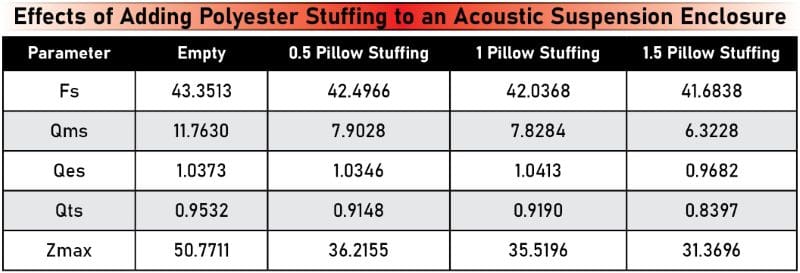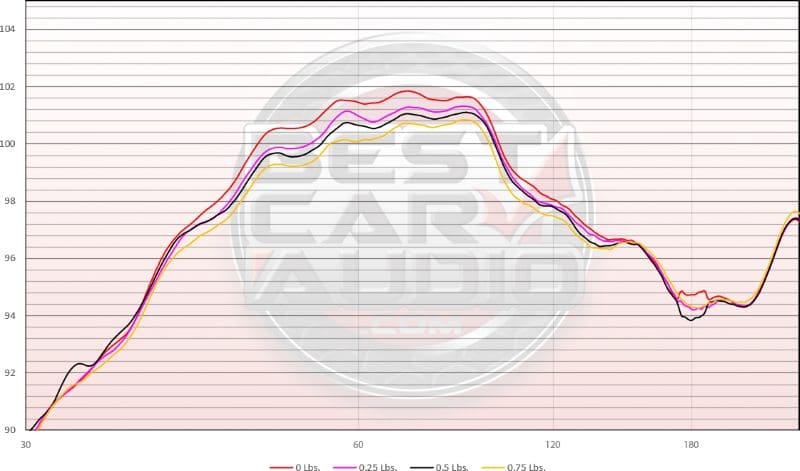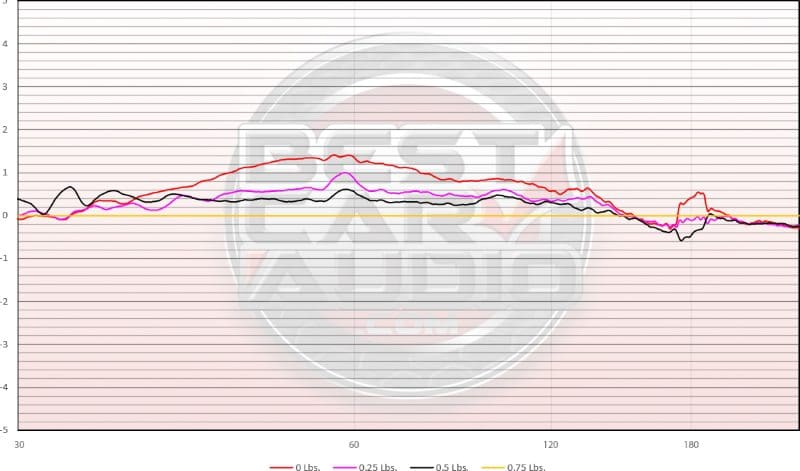A while back, we looked at how adding stuffing to a sealed enclosure affects its performance. It was clear from our measurements that the addition of Dacron lowered the system’s Qtc (Total Q). The original theory was that adding stuffing made the enclosure seem larger and let the driver play louder at low frequencies. Let’s revisit this test and add several acoustic measurements to quantify any changes in efficiency and output.
Results from Our Original Testing
Our original article determined that adding different amounts of stuffing to our 1.358-cubic-foot enclosure lowered the system Qtc. Without stuffing, the Qtc with our audiophile-grade 12-inch subwoofer was 0.9532. That’s a bit high for our liking but offers good efficiency. With 0.25 pound of Dacron added to the enclosure, the Qtc dropped to 0.9148. That’s still on the high side but getting better.
Moving up to a half-pound of stuffing had minimal effect on the driver, and the system stayed roughly the same at 0.919. Cramming another quarter-pound of stuffing into the enclosure made a truly beneficial change. The Qtc was now down at 0.8397. The lower Qtc measurement is better as it results in less resonance and a tighter, more controlled bass perception. In this capacity, stuffing with Dacron does have the same effect as installing the subwoofer in a larger enclosure.
The driver’s resonant frequency in the enclosure barely changed throughout the test. Empty, the system had an F3 of 43.35 hertz. With all the stuffing in place (0.75 pound), the resonant frequency dropped to 41.68 hertz. The difference would be negligible and doesn’t support the claims of stuffed enclosures playing lower.

Round Two of Subwoofer Enclosure Testing
In this test, we’ll use the same enclosure and subwoofer and take several acoustic measurements under strictly controlled conditions. We’ve set the enclosure up in the middle of our lab and placed the Clio Pocket calibrated mic on the floor 50 centimeters in front of the enclosure. This configuration is similar to a typical ground-plane measurement, except the closer proximity to the enclosure will help to reduce the effect the room has on the measurements. A “normal” ground-plane measurement would have the microphone 2 meters from the enclosure. We will continue buying lottery tickets in hopes of financing our own anechoic chamber, but that might take a while!
All measurements are at the same output level. We’ll use 4 volts representing 2 watts of power into the subwoofer’s nominal 4-ohm load. With a drive level any lower than this, the background noise from the HVAC system starts to mess with the very low frequency measurements. Again – anechoic chamber, please!
Sealed Enclosure Stuffing Findings
If you look at the graph below, you’ll see the SPL measurements from the four test conditions. The red trace is the enclosure without any stuffing. The violet trace represents 0.25 pound of stuffing. The black trace represents a half-pound of filling. Finally, the amber trace is 0.75 pound.
As expected, the more stuffing there is, the smaller the bump at the top of the response curve. Why does this happen? Because polyester fiberfill reduces the resonance of the system. With less resonance, the driver returns to rest faster after the signal stops, and less distortion is added to the output.

You’ll notice the difference between no stuffing and the tightly packed enclosure is relatively tiny. Indeed, the maximum difference is a total of 1.4 dB SPL, with the unstuffed enclosure being louder.
I generated a second graph referencing the first three measurements to the fully stuffed measurement. This analysis shows you how much louder the subwoofer is as there is less and less stuffing. While it might be noticeable, the difference is minute.

Sealed Enclosure Stuffing Summary
Unlike what many “old timers” will tell you, adding a large amount of Dacron (or similar) stuffing doesn’t significantly affect output, especially at lower frequencies. It certainly doesn’t cause the same improvement of the low-frequency production that you’d get from a larger enclosure. One consideration, though: If the crossover point for our subwoofer systems is, or should be, around 80 Hz, then a system with a flatter response will seem to be a bit louder at lower frequencies. With that said, we are talking about less than 1.5 dB SPL, so the whole thing regarding output amplitude is effectively irrelevant.
So, is it worth asking the shop building your sealed subwoofer enclosure to add stuffing? Don’t add anything if you’re a bass head and want the system to play as loudly as possible. If you’re into sound quality and want to reduce distortion around the resonant frequency of the subwoofer system a bit, then go for it. It’s not like the cost of some stuffing is significant.
This article is written and produced by the team at www.BestCarAudio.com. Reproduction or use of any kind is prohibited without the express written permission of 1sixty8 media.


Leave a Reply